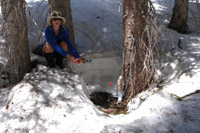- Home
- About S&T
- Taxa/Organisms
- Ecosystems
- Issues
- Methods & Tools
- Reports & Publications
- Location
- Search
Publisher: USGS | Science Center: National Wetlands Research Center (NWRC, Lafayette) | Format: URL
www.nwhc.usgs.gov — Frog malformations have been reported from 42 states. The broad geographic distribution of these malformations warrants national attention. This website directs to resources on amphibian malformation that include a field guide to malformations of frogs and toads, the Vermont Frog Report (through 1997), USGS Amphibian Research and Monitoring More...

Publisher: USGS | Science Center: Patuxent Wildlife Research Center (PWRC, Laurel) | Format: URL
igsaceeswb00.er.usgs.gov:8080 — From the Web site: "The Amphibian Research and Monitoring Initiative (ARMI) National Atlas for Amphibian Distributions (or simply, the ARMI Atlas), is a compilation of current and historic records of amphibian occurrences. These records are from published, peer-reviewed scientific literature, museum records, state and regional herpetological More...

Publisher: USGS | Format: URL
armi.usgs.gov — The U.S. Geological Survey's Amphibian Research and Monitoring Initiative (ARMI) is a multidisciplinary effort to determine the status and trends of amphibians in the U.S., research the causes for amphibian declines, and provide scientific information to decision-makers to help halt or reverse declines. This website includes information on ARMI's More...

Publisher: USGS | Science Center: Northern Prairie Wildlife Research Center (NPWRC, Jamestown) | Format: URL
www.npwrc.usgs.gov — Interest in amphibians continues to rise as people become more aware of this fascinating group of animals. To the uninitiated all frogs may look alike; ditto for salamanders (in the same manner that beginning birders are overwhelmed by the immense variety of small brown birds). One of the purposes of this checklist and online identification guide More...

Publisher: USGS | Science Center: Patuxent Wildlife Research Center (PWRC, Laurel) | Format: URL
www.pwrc.usgs.gov — Information about ecotoxicological exposure and its effects on terrestrial vertebrates residing in estuarine and coastal habitats like the Atlantic, Gulf and Pacific Coasts, Alaska and Hawaii, as well as the Great Lakes. These vertebrates include birds, mammals, amphibians and reptiles. The data is a compilation of results from computerized More...

Publisher: USGS | Science Center: Patuxent Wildlife Research Center (PWRC, Laurel) | Format: URL
www.pwrc.usgs.gov — BEST Large River Fish Health Data Query Tool provides a simplified portal for accessing database that serves fish health endpoints measured through the Biomonitoring of Environmental Status and Trends (BEST) Project's Large River Monitoring Network (LRMN). The tool allows the user to search the database by species, chemical, river basin, sampling More...

February 2004 | Publisher: USGS (Amphibian Research and Monitoring Initiative (ARMI)) | Science Center: USGS Other | Format: URL
armi.usgs.gov — At least 13 amphibian species are found on the Colorado Plateau, although some have very limited distributions in this bioregion. Amphibian declines have been documented in many parts of the world, but knowledge of amphibians on the Colorado Plateau is inadequate to determine population status or trends for most species. The U.S. Geological More...

Publisher: USGS | Science Center: National Wetlands Research Center (NWRC, Lafayette) | Format: URL
www.nwrc.usgs.gov — The south-central region includes the States of Texas, Oklahoma, Arkansas, Mississippi, and Louisiana. We are currently conducting research projects designed to monitor amphibians on Federal lands in these States and to research possible causes of declines in amphibian populations. These potential threats include loss or degradation of habitat, More...

Publisher: USGS | Science Center: Forest and Rangeland Ecosystem Science Center (FRESC, Corvallis) | Format: URL
fresc.usgs.gov — The Conservation Genetics Lab carries out molecular analysis, pedigree analysis, modeling, data management, and cryogenic sample repository. As a part of this research, the lab investigates the effectiveness of molecular markers used to enhance enforcement of the Endangered Species Act policy. During the past 15 years, this research has involved More...

Publisher: USGS (South Florida Information Access (SOFIA)) | Science Center: USGS Other | Format: URL
sofia.usgs.gov — This project uses data on detection of amphibian species after repeated sampling at a site to estimate the occupancy rate of various amphibian species (MacKenzie et al., 2002). Declines in amphibian populations have been documented for many regions and habitat types worldwide (Alford and Richards, 1999). No single cause for declines has been More...

Publisher: USGS | Science Center: Columbia Environmental Research Center (CERC, Columbia) | Format: URL
www.cerc.usgs.gov — The primary goal of the proposed research is to evaluate selenium and atrazine exposure and effects to fish, amphibians, and waterfowl that utilize the Refuge. The following subordinate objectives will be met to investigate selenium exposure and effects to wildlife on the Refuge: 1.Measure selenium concentrations and total organic content in More...

Publisher: USGS | Science Center: Fort Collins Science Center (FORT, Ft. Collins) | Format: URL
www.fort.usgs.gov — Encroaching development, overuse, and air- and waterborne contaminants from outside park boundaries are causing noticeable changes to water quality and ecosystem health and functioning. The Front Range metropolitan area from Fort Collins south to Colorado Springs includes 75 percent of Colorado's population and its most productive agricultural More...
